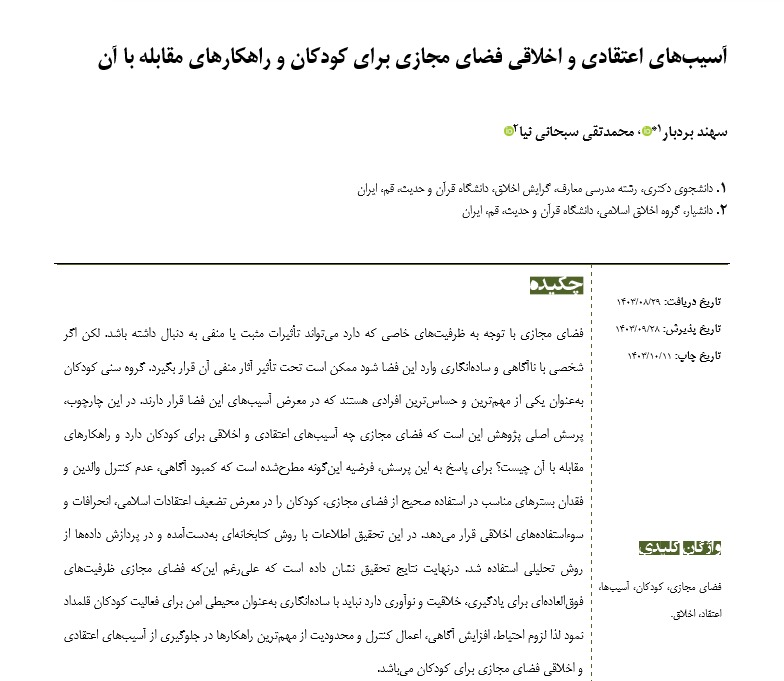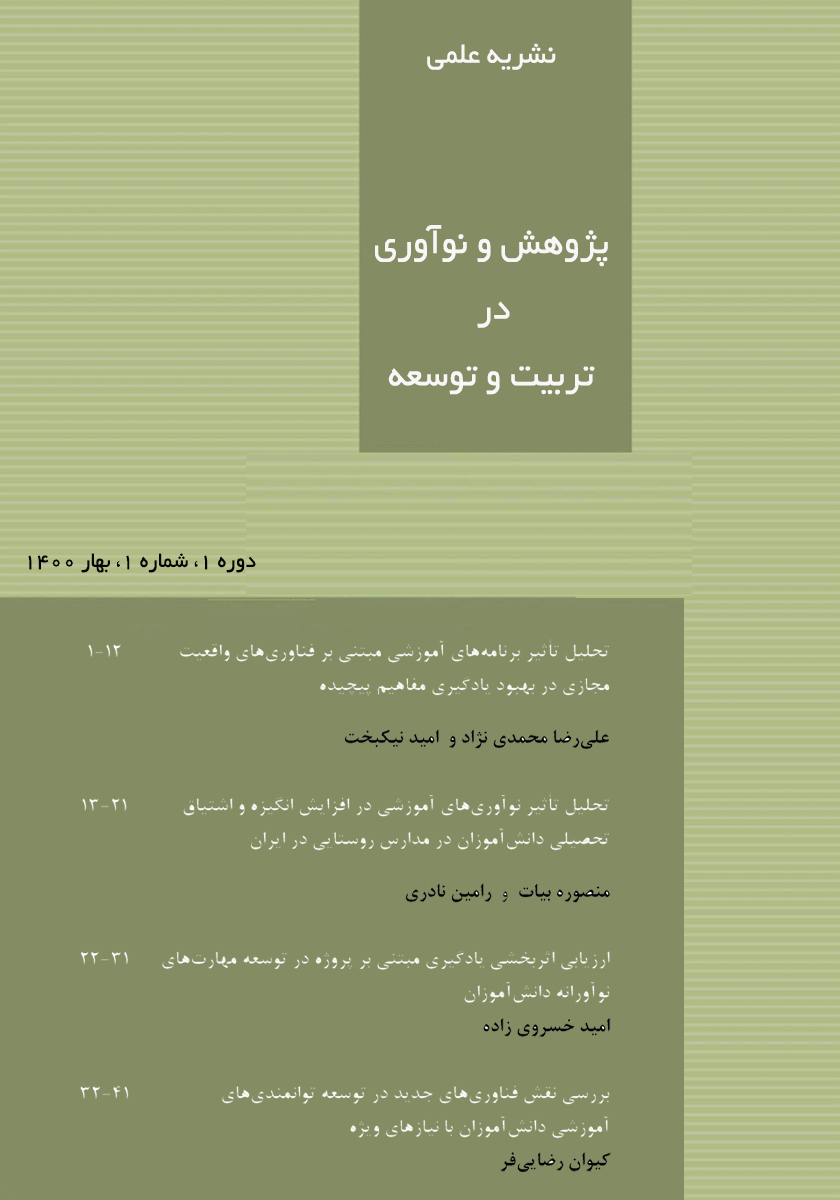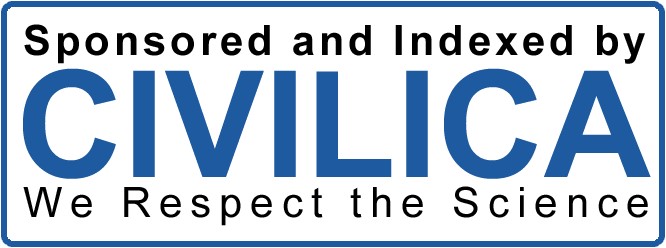آسیبهای اعتقادی و اخلاقی فضای مجازی برای کودکان و راهکارهای مقابله با آن
کلمات کلیدی:
فضای مجازی, کودکان, آسیبها, اعتقاد, اخلاقچکیده
فضای مجازی با توجه به ظرفیتهای خاصی که دارد میتواند تأثیرات مثبت یا منفی به دنبال داشته باشد. لکن اگر شخصی با ناآگاهی و سادهانگاری وارد این فضا شود ممکن است تحت تأثیر آثار منفی آن قرار بگیرد. گروه سنی کودکان بهعنوان یکی از مهمترین و حساسترین افرادی هستند که در معرض آسیبهای این فضا قرار دارند. در این چارچوب، پرسش اصلی پژوهش این است که فضای مجازی چه آسیبهای اعتقادی و اخلاقی برای کودکان دارد و راهکارهای مقابله با آن چیست؟ برای پاسخ به این پرسش، فرضیه اینگونه مطرحشده است که کمبود آگاهی، عدم کنترل والدین و فقدان بسترهای مناسب در استفاده صحیح از فضای مجازی، کودکان را در معرض تضعیف اعتقادات اسلامی، انحرافات و سوءاستفادههای اخلاقی قرار میدهد. در این تحقیق اطلاعات با روش کتابخانهای بهدستآمده و در پردازش دادهها از روش تحلیلی استفاده شد. درنهایت نتایج تحقیق نشان داده است که علیرغم اینکه فضای مجازی ظرفیتهای فوقالعادهای برای یادگیری، خلاقیت و نوآوری دارد نباید با سادهانگاری بهعنوان محیطی امن برای فعالیت کودکان قلمداد نمود لذا لزوم احتیاط، افزایش آگاهی، اعمال کنترل و محدودیت از مهمترین راهکارها در جلوگیری از آسیبهای اعتقادی و اخلاقی فضای مجازی برای کودکان میباشد.
دانلودها
مراجع
Izadi-Fard AA, Hossein-Nejad SM. Electronic Jurisprudence in the Islamic-Iranian Model of Progress. Tehran:
Institute of Islamic-Iranian Model of Progress; 2016. 33 p.
Hasanbeigi E. Rights and Security in Cyberspace. Tehran: Institute of Contemporary Abrar Studies and Research;
Javidi E, Ahmadi H, Rajabi M. A Sociological Study of the Impact of Virtual Social Networks on the Generation Gap:
A Case Study of Shiraz University Students. Scientific-Research Quarterly of Social Development. 2021;16(2):1-32.
Dardashti AR. On the Reasons for the Spread of Mass Doubts in Cyberspace. 2016 2016-02.
Tomczyk Ł, Solecki R. Problematic Internet Use and Protective Factors Related to Family and Free Time Activities
among Young People. Educational Sciences: Theory and Practice. 2019;19:1-13. doi: 10.12738/estp.2019.3.001.
Barazandeh M. Addiction to Mobile Phones and Cyberspace: A Serious Threat to Families. 2022 2022-06-20.
Malek Shoar M, Tadayon A. The Impact of Cyberspace on Committing Immoral Acts. Tali'eh-e-Hoqoq Journal.
(6):150-88.
Smith PK, Madsen K, Moody J. What causes the age decline in reports of being bullied in school? Towards a
developmental analysis of risks of being bullied. Educational Research. 1999;41:267-85. doi: 10.1080/0013188990410303.
Zare'an A. What Do You Know About Virtual Violence? 2021.
Kharazani SH. The Relationship Between Cyber Usage and Students' Tendency Towards Violence. Information and
Criminal Research. 2016;11(1):161-84.
Malahi N. The Role of Islamic Religious Teachings in Preventing the Destructive Effects of Cyberspace on Families.
Rahnaward-e-Noor Quarterly. 2017(60):55.
Munro ER. The protection of children online: a brief scoping review to identify vulnerable groups. 2011.
Ghanizadeh Bafghi M, Hosseinzadeh Sarsheki A. An Inquiry into the Phenomenon of Cyber Pornography and Child
Cyber Seduction in Light of Iranian Jurisprudence and Law. Article 8. 2023;28(78):197-228.
Chandler D, Munday R. A Dictionary of Social Media. Oxford: Oxford University Press; 2016.
Patchin JW. Catfishing as a Form of Cyberbullying. Cyberbullying Research Center. 2013.
Barqi R, Mostaneh Y. The Impact of Cyberspace on the Islamic Education of Students: Challenges and Solutions.
Rahnaward-e-Noor Quarterly. 2018(63):35-45.
Montgomery C. Is YouTube Kids Safe? What Is YouTube Kids? 2023 [updated December 17, 2023]. Available from:
https://parentintel.com/is-youtube-kids-safe.
Ghasemzadeh Barki S, Manteghi M, Mohammadi M. Examining Mothers' Abuse of Children in Blogging and Its
Impact on Their Psychological Health. Research in Psychological Health. 2020;14(2):34-49.
Shahid Thani Za-DiA. Al-Rawdah al-Bahiyyah fi Sharh al-Lum'ah al-Dimashqiyyah: Section of Shia Jurisprudence
of the Eighth Century; 1967.
Qadiri Modarres MJ. Misleading Books from the Perspective of Imamiyya Jurisprudence and Iranian Law: Master's
thesis in Islamic Studies, Department of Jurisprudence and Fundamentals of Islamic Law; 2013.
Meshkini AAF. Istilahat al-Usul wa Mu'azam Abhathiha. Qom: Al-Hadi Publications; 1992.
Bojnourdi H, Mehrizi M, Derayati MH. Al-Qawa'id al-Fiqhiyya (Al-Bojnourdi). Qom, Iran: Al-Hadi Publications;
Tusi MiH. Al-Amali. Islamic Studies Section: Al-Ba'thah Institute; 1994.

دانلود
چاپ شده
ارسال
بازنگری
پذیرش
شماره
نوع مقاله
مجوز
حق نشر 2024 نشریه پژوهش و نوآوری در تربیت و توسعه

این پروژه تحت مجوز بین المللی Creative Commons Attribution-NonCommercial 4.0 می باشد.










